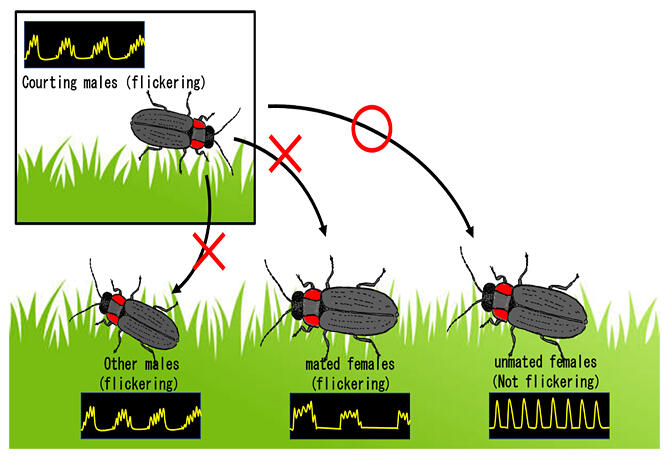Researcher Hideo Takatsu and Professor Yuichi Oba from Chubu University's College of Bioscience and Biotechnology, and Professor Mihoko Minami from Keio University's Faculty of Science and Technology, have revealed that male and female Aquatica lateralis fireflies communicate using luminescent signals and that the flickering of their lights helps them distinguish between males, unmated females, and mated females. It marks the first experimental confirmation that the species uses the flickering of their lights to communicate. The study was published in the online edition of Scientific Reports.

Provided by Chubu University
Aquatica lateralis can be found throughout Japan, the Korean Peninsula, and northern China and are visible in rice paddies and wetlands around July and August. The species flickers its light at the millisecond level, a behavior mainly seen amongst males perched on grass. However, this flickering cannot be seen in Nipponoluciola cruciata, a species native to Japan. Until now, it was not known why Aquatica lateralis flickered its lights this way.
The research group first videotaped wild examples in rice paddies in Higashiuracho, Chita‐gun, Aichi Prefecture and analyzed the videos.
They found that three types of fireflies perched on grass: males, unmated females, and mated females, each of which exhibited a different luminescence pattern. Males approach unmated females using a series of rapid millisecond‐level flickers along with flashes. The flashes of the unmated females at this time had no flickers, and the duration of each was very short.
However, the flashes of mated females perched on the grass had male‐like flickers and a slightly longer duration per flash. In other words, males are thought to identify mates by searching for individuals with luminescence patterns that do not flicker and have single short flashes.
Next, using small LED lamps that glow the same yellowish‐green color as Aquatica lateralis, the team created and programmed artificial firefly lights with different emission durations and flickering intensities and installed them in the field (electronic fireflies).
Statistical data analysis revealed that small flickers and short flashes strongly attracted male Aquatica lateralis perched on grass.
Previous studies of luminescent communication in fireflies have involved simple temporal factors (emission times, response delay times, etc.). However, the results of this statistical analysis of in‐the‐field observations and experiments using electronic fireflies revealed for the first time that the millisecond‐level amplitude component of the flickering is also used as information.
Other fireflies around the world also flash and flicker their luminescence. Presumably, these fireflies also communicate through flickering.
Journal Information
Publication: Scientific Reports
Title: Flickering flash signals and mate recognition in the Asian firefly, Aquatica lateralis
DOI: 10.1038/s41598-023-29552-6
This article has been translated by JST with permission from The Science News Ltd. (https://sci-news.co.jp/). Unauthorized reproduction of the article and photographs is prohibited.




